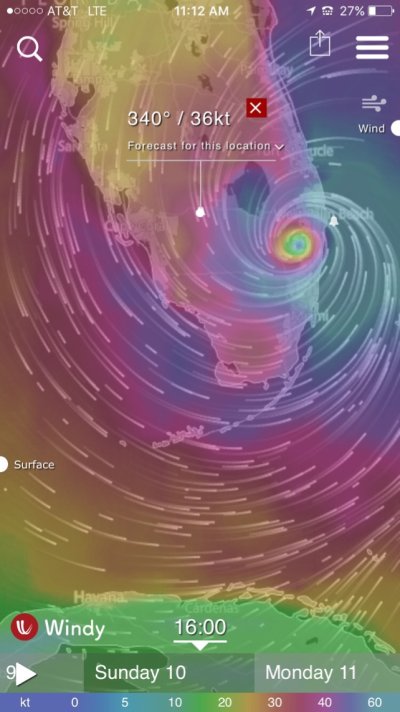@BandB, don't get me wrong, i'm happy to hear you say you "only" expect winds of 75mph-100mph. That definitely makes me feel better about our odds, but how do you figure that when they are predicting CAT4 at the time it hits Miami and the new models showing this thing tracking almost right down the coast. Appreciate your input on this.
To elaborate on my situation, we are at Cracker Boy, right across from peanut. No racks near us, but the boats are ~15 ft apart. hoping that shields us from the wind, if she does end up coming up the east coast that big yacht to our east should help. We displace ~65 tons so hopefully that works to our advantage, but we also have a ton of windage. Unfortunately there are lots of smaller vessels around that could easily swipe out our supports if there was a surge, nothing we can really do about that. No good way to anchor the boat to the pavement so we're at a loss with tying her down in any sort of effective way. Gonna put water in the bilge to have some more weight down low and hope for the best.
-Pete
The worst winds aren't projected in either model to hit Miami directly. Note that even the areas "hit" so far were not hit by 175 mph winds. They were hit by a hurricane with 175 mph recorded winds. The GFS has it running offshore. The Euro model just moved west a bit since I wrote that but has it moved west a bit more again and now has it running up the middle of the state. The current Euro model has it down to 130 mph maximum sustained speed by the time it passes Miami.
Now that's not saying it can't hit where you are at 145 mph, just that it's unlikely. It can still do a lot of damage at lower speeds and in the areas that don't get the maximum speeds. It's way different from Andrew in the respect of size. Andrew was intense, fast and narrow. I don't know if you were in South Florida, but sure you've read of the damage in Miami from Andrew. However, 10 miles north of the worst hit area there was little damage. It didn't hit Fort Lauderdale. This hurricane is under one model going to impact the entire width of the peninsula and under the other at least half the width.
We have to all plan for the worst, but we won't all get the worst, if that makes sense. It's shown to be 90 mph by the time it hits SC. Well, Matthew did huge damage to SC and they had major damage just from an unnamed storm in October 2015.
In considering our situation we've considered it all. House built to 150 mph standards but what if it collapses. Generator but what if no gas. RIB but what if it's destroyed. Walk but what if power lines down. 100 year surge is under 6' but what if 15'.
We can evacuate to condos 2.2 and 3.2 miles from us or offices or businesses west but not convinced any of them are safer. Definitely flying to Las Vegas would have been safer, but this is our home and unanimously everyone in our group and extended family wants to be here. As to boats, they're as protected as any boats can be. However, 150 mph structures can collapse, all lines could break, other boats could come flying in from all directions.
All we've done is managed our risk to what for us is an acceptable level.
Human nature though isn't always right. We have an older couple we moved here with us. They're in their 60's and they're concerned as are all of us. We offered to fly them out. We plead with them to leave. We cross examined them to be sure they didn't want to stay out of loyalty to us. They didn't budge.
As to your boat, you're doing all you can. Highly unlikely surge is going to toss boats into you. Wind may. 15' is certainly better in terms of domino effect than 2 and 3' we saw a lot of in South Texas. At 15' apart, many boats would have been saved or suffered far less damage.
I talked to an employee who was in Miami Lakes for Andrew. They lived in the apartments over the town. They were told by the complex to leave although the city and county said not to. They stayed but had a new car and so with the parking lot empty they drove it around the lot looking to get out of falling range of a palm tree. They couldn't find such a spot. So they parked where they considered best, went inside. Got ready to look out about 9:00 the following morning or so and said after safely coming through Andrew they figured their car was destroyed but no big deal. Well, two trees fell with both landing with a foot of it. Not a scratch on the car.
If we come out of this alive and unhurt, then it's a victory. House, cars, boats, all just extra prizes.



